Tartan and Kilts – The Origins
With powerful connotations of clanship, kinship and national identity the image of the tartan-clad highlander is deeply engrained in the popular memory. It is so engrained, in fact, that is virtually impossible to think of Scotland and clans, and not think of tartan at the same time.
Tartan: a textile and a design pattern
The word ‘tartan’ refers to both a fabric and a pattern – as a pattern it is a multi-coloured, checked design where different coloured yarns are woven in equal proportions. The more colours that are used, the more complex the pattern (or sett) can appear.
Before the invention of synthetic dyes in the mid-nineteenth century, all colours used in tartan were from natural dyestuffs. Some of these were native to Scotland while others, such as cochineal used to make red, were imported from South America. This made red more expensive and thus high status, and it explains why a number of elite men in particular are depicted in tartan with a lot of red.
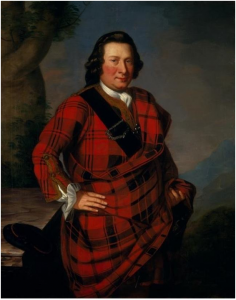
Charles Campbell of Lochlane, died 1751. Advocate. ©National Galleries of Scotland
Tartan is most commonly associated with the Highlands, but it was also worn in the Lowlands of Scotland since at least the sixteenth century. King James the Fifth (1513-1542) had tartan coats and tartan hose (stockings) in his wardrobe in the 1530s and the image of Charles Campbell of Lochlane shows how the tartan could be incorporated into the fashionable clothing of the elite in the early seventeenth century.
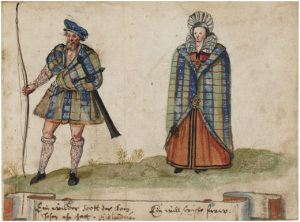
Seventeenth-century watercolour in a travel book by Hieronymous Tielssch. ©Huntington Library, Pasadena, CA, USA.
Clan tartans, in contrast, are much more recent and date to the late eighteenth and early nineteenth centuries. Before this, distinctive patterns were more likely to be associated with a region or locality. Martin Martin of Skye wrote about these ‘district tartans’ in the 1690s and noted that people were able ‘at first view of a man’s plaid to guess the place of his residence.’
Portraits are useful for demonstrating how clan tartans were not in existence before the end of the eighteenth century, with some outfits consisting of multiple tartans, as well as tartan patterns that cannot be identified today.
This portrait of Andrew Macpherson of Cluny (1640-1660), the chief of the Macphersons depicts him in a complete tartan outfit: the triubhas or trews and jacket are of the same tartan, while the plaid which is wrapped around his body and left arm is of a different sett.

Andrew Macpherson of Cluny (1640-1666), fifteenth chief. Artist: Richard Waitt. © The National Galleries of Scotland
Tartan as political symbol
In the eighteenth century tartan became a symbol of Jacobite support in the Rising of 1745 led by Prince Charles Edward Stuart. This association was so strong that when the Jacobites were defeated, Highland dress was banned in Scotland from 1746/7 to 1782 as part of the Proscription Act. While tartan itself was not actually banned, the fact that most, if not all, Highland dress was made of tartan meant it developed rebellious or loyal connotations (depending on which side you were on).
Importantly, however, there were a number of loopholes in the Proscription Act: Highland dress could still be worn by soldiers in the Highland regiments. Each regiment had its own tartan, most of which were variations of what has been called the ‘government tartan’, which was dark green, blue and black – first associated with the 42nd Highland Regiment, ‘The Black Watch’. As such, tartan does not disappear from the public consciousness and you could argue that this ‘regimentation’ of tartan helps the development of later clan tartans.
This standardisation of tartan can be seen in this 1780 portrait of Hugh Montgomerie, twelfth earl of Eglinton, by John Singleton Copley. It depicts Montgomerie in the uniform of the 77th Highland Regiment campaigning in 1760 against the Cherokee nation on the frontier of what was then the British colony of North Carolina.
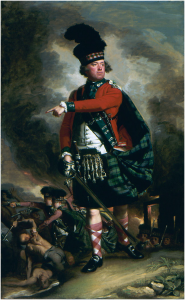
Hugh Montgomerie, twelfth earl of Eglinton by John Singlton Copley, 1780. ©John Singleton Copley [Public domain]
The ‘standardisation’ of tartan
The Proscription Act was repealed in 1782 and by the turn of the nineteenth century a number of clubs and societies existed that were concerned with preserving what they saw as Highland culture. These ‘Highland societies’ were set up by elite men who would meet to discuss Highland poetry, literature and music. Members were encouraged to wear tartan and Highland dress to these meetings and it is at this point that we start to see more references to ‘clan tartans’.
While the harshness of the 1745 Rising and the clearances and famine were felt all too keenly in the glens much further south, in the Borders, the Jacobite rebellion produced a quite different effect. It stirred the imagination of Sir Walter Scott and was the inspiration for the first of his wildly successful historical novels. Waverly was published in 1814 and subtitled ‘Tis Sixty Years Since’, since the rebellion he meant.
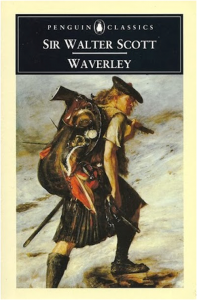
Sir Walter Scott first romanticized the Jacobite Risings in prose fiction in 1814’s Waverley, a historic novel that became hugely popular in the United Kingdom.
Waverly romanticised the rebellion and its major protagonists, exerting a tremendous influence on the way the middle and upper classes saw the Jacobites and their adherents. Romance swirled around the misty mountains once more.
An extraordinary event took place in 1822. It was decided that George IV would make a state visit to Scotland, the first reigning monarch to go north since George II. And because his writing had made him the most famous Scotsman of the time Scott was asked to stage manage the event.
In August 1822 the traditionally built George IV spent two weeks at the centre of a tartan extravaganza. Persuaded by Scott into a Royal Stewart kilt worn several inches above the knee over flesh-coloured tights, the flesh coloured king careened his way through parties and balls at Holyrood Palace. ‘Since he is here for such a short time,’ remarked one witty Edinburgh lady ‘it is well that we see so much of him.’
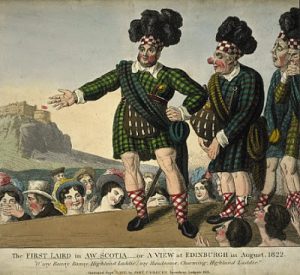
The visit of King George to Edinburgh in 1822 drew merciless caricature.
Following this pantomime the popularity of tartan surged and the notion that particular surnames had some sort of right to a particular tartan added a unique marketing twist. This was further developed by the Sobieski-Stewart brothers, John and Charles Edward. Claiming to be descendants of Bonnie Prince Charlie they compiled and allegedly ancient list of clan tartans with the sonorous and serious title of Vestiarium Scoticum. Clearly bogus, widely trusted and much consulted, it is the origin of many of today’s so-called clan setts.
In 1815, the Highland Society of London wrote to clan chiefs to ask them for samples of clan tartans so that they could be authenticated and preserved. Many of these chiefs in turn had to enquire of tartan manufacturers what their clan tartan was, and in some cases these were created based on an existing district tartan and sometimes an entirely new pattern was produced.
The Scottish Register of Tartans keeps track of the registered tartan setts, continuing the legacy of the Highland Society of London and showing just how varied, vibrant and versatile tartan can be.
Putting on the plaid
Tartan could be incorporated into many aspects of Highland dress but it is the feileadh mor (literally the ‘great wrap’) or great plaid that is perhaps the most distinct.
The great plaid was a large pie expanse of material, approximately 70cm by 5 metres (2 yards wide and 4-5 yards in length).
It was uncut and untailored, typically but not always made from tartan. The plaid was wrapped around the waist of the wearer to create a kilt-like effect that stopped above the knee and the remaining fabric was draped around the torso in various ways. It was worn with a shirt and coat, tartan hose (stockings) or triubhas or trews which were a tight-fitting lower garment, also made of tartan, that encased the leg from foot to waist.
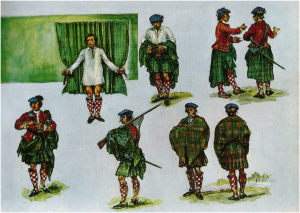
The plaid. The Highlander would lay the cloth down, pleat the middle section, then wrap it around the body with a belt. By tucking in the corners you could make pockets.
A description from 1746 states: (Forbes, Lord Culloden, Duncan (1815), Culloden Papers, London: T. Cadell & W. Davies, p. 289)
The garb is certainly very loose, and fits men inured to it to go through great fatigues, to make very quick marches, to bear out against the inclemency of the weather, to wade through rivers, and shelter in huts, woods, and rocks upon occasion; which men dressed in the low country garb could not possibly endure.
For battle, it was customary to take off the kilt beforehand and set it aside, the Highland Charge being made wearing only the léine croich or war shirt, a knee-length shirt of leather, linen or canvas, heavily pleated and sometimes quilted as protection.
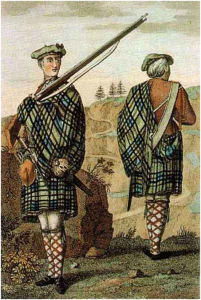
A Highland Soldier, from Francis Grose’s Military Antiquities Respecting a History of the English Army (1786). © [Public domain]
This is a print of Highland soldiers showing different ways the plaid could be worn. It is taken from Francis Grose’s Military Antiquities Respecting a History of the English Army (1786).
Other garments like breeches and trews required the skill of a tailor to cut and sew them and this made them more expensive and more exclusive. Because the plaid was a simple piece of fabric, it could be worn by anybody. But you could still assert your status by wearing a higher quality fabric or more intricately patterned piece.
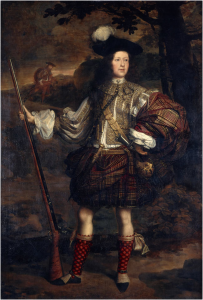
Lord Mungo Murray (Am Morair Mungo Moireach) 1680s. Artist: John Michael Wright. ©John Michael Wright [Public domain]
The tightly woven woollen cloth used for plaids was practical for the climate of the Highlands, and commentators noted its use as bedding as well as clothing. Edmund Burt, for example, made this observation in the early eighteenth century:
…when the Highlanders are constrained to lie among the hills in cold, dry, windy weather, they sometimes soak the plaid in some river or bourn [stream]; and then holding up a corner of it a little above their heads, they turn themselves round and round, till they are enveloped by the whole mantle. Then they lay themselves down on the heath, where the wet and warmth of their bodies make a steam like that of a boiling kettle. The wet, they say, keeps them warm by thickening the stuff, and keeping the wind from penetrating.
By the time Burt was writing the great plaid was slowly being replaced by the feileadh beag which translates to ‘little wrap’ but is commonly known as the ‘kilt’. The single piece of material for the great plaid was now in two pieces, with one wrapped or kilted around the waist, and the other worn over the shoulder. A common story is that this was the idea of an Englishman who ran a mill in Argyll in the early eighteenth century and thought that the Highlanders who worked for him would benefit from what getting rid of the cumbersome plaid. While the timing is roughly correct and fits with early references and depictions of the kilt, it is more probable that the great plaid had been in the process of evolving into the little kilt for a number of years.
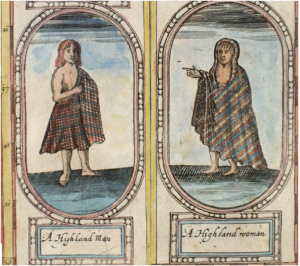
A ‘Highland’ Man and a ‘Highland Woman’. A Map of Scotland, 1660. John Speed. © National Library of Scotland.
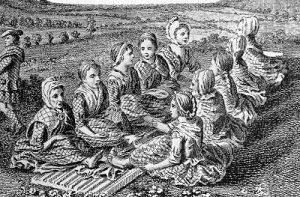
Women in the Highlands and Lowlands also wore a plaid as an outer garment, covering their gowns and petticoats. In the Highlands, the women’s plaid was called an earasaid or arisaid. Like the men’s plaid this could be made from tartan but it often had different colour schemes such as a white or lighter coloured ground with red or yellow stripes. It was worn much like a shawl and we can see quite easily how it might have been put on. The men’s great plaid, however, is another question and there are a number of theories as to how a highlander got dressed in this manner.
The Scottish Register of Tartans
Tartans don’t have to be registered. There are quite a lot of tartans that are designed, particularly by the commercial trade, that don’t get registered. And there are tartans designed all over the world. In Scotland, the Scottish Register of Tartans was established by an Act of the Scottish Parliament in 2008. It is the official government-sponsored repository where you register the tartans. But it doesn’t have every tartan, ironically. The Register was only set up in 2008, so they’ve only been recording tartans since then. They started with some of the Scottish Tartan Authority’s records, with some of those more common patterns as a basis, and they’ve added about 1,500 since then. But they don’t have the number that we’ve got or the more unusual patterns. A lot of the Scottish Tartan Authority’s work is about restoring or preserving old specimens, etc., and those are the things which nobody is really interested in.
The Scottish Tartan Authority is a registered charity and the only organisation dedicated to the preservation, promotion and protection
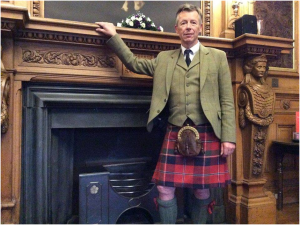
Scottish Tartans Authority historian Peter MacDonald wears a kilt in his handwoven reconstruction of the MacDonald of Glenaladale tartan.
of Tartan. Individual annual membership is available for £20.
Reference
The Highland Clans Alistair Moffat. Thames and Hudson 2013
https://en.wikipedia.org/wiki/History_of_the_kilt
https://www.collectorsweekly.com/articles/debunking-the-myths-about-kilts/
